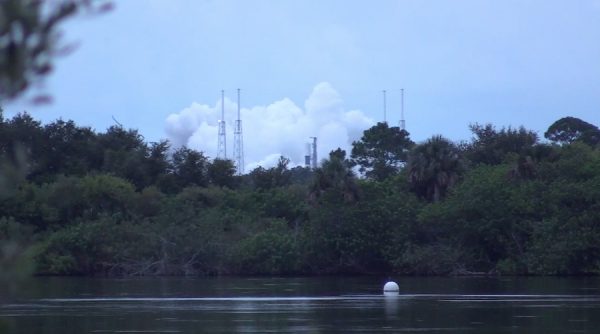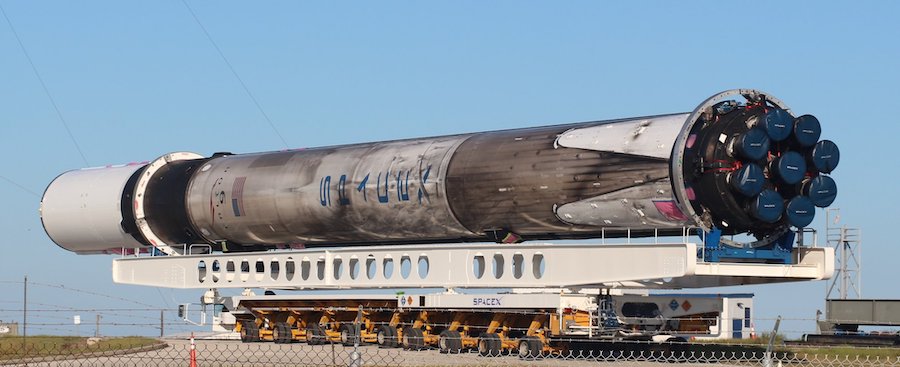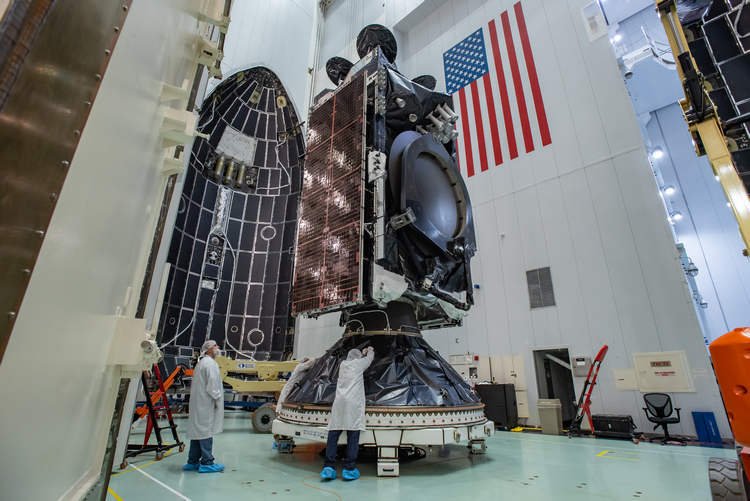SpaceX targets Saturday launch with Amos 17 communications satellite – Spaceflight Now

SpaceX test-fired a Falcon 9 rocket at Cape Canaveral on Wednesday evening, clearing the way for liftoff with the Israeli-owned Amos 17 commercial communications satellite Saturday, pending favorable weather and the completion of final preflight data assessments.
After completing a mock countdown, the Falcon 9’s nine Merlin 1D first stage engines ignited for several seconds at 8 p.m. EDT Wednesday (0000 GMT Thursday) at Cape Canaveral’s Complex 40 launch pad as hold-down clamps kept the rocket firmly on the ground.
SpaceX said the launch team was “assessing data” Wednesday night after the test-firing, which is a customer milestone in all SpaceX launch campaigns. Ground crews planned to remove the rocket from the launch pad Thursday and return to a hangar south of pad 40 for attachment of the Amos 17 spacecraft, already encapsulated inside its payload shroud.
The Boeing-built Amos 17 satellite is owned by Spacecom Ltd., an Israeli company based in Tel Aviv. The last time a Spacecom-owned satellite was to launch on a SpaceX rocket, the spacecraft was destroyed during an explosion minutes before a planned static fire test.
Since that accident, SpaceX has no longer placed one of its customer payloads on the rocket for the static fire test.
Liftoff of the Falcon 9 rocket with Amos 17 is scheduled for Saturday during a launch window opening at 6:52 p.m. EDT (2252 GMT) and extending to 8:20 p.m. EDT (0020 GMT).

SpaceX’s team at Cape Canaveral aims to launch Amos 17 just nine days after the last launch from pad 40, which occurred July 25 with a Dragon supply ship heading for the International Space Station.
The nine-day turnaround at pad 40 would be the shortest span between liftoffs from the same launch pad in SpaceX’s history.
The Falcon 9 rocket launching with Amos 17 will fly in expendable mode without any landing legs. The heavy weight of Amos 17, at some 6.5 metric tons (14,330 pounds) fully fueled, requires all of the Falcon 9’s lift performance to deliver it into a geostationary transfer orbit stretching more than 22,000 miles (nearly 36,000 kilometers) over the equator.
This will be the second time SpaceX’s has flown one of its Falcon 9 rockets in the new-generation “Block 5″ configuration without attempting a recovery of the first stage.
The booster launching with Amos 17 previously flew two times from Cape Canaveral last year to send the Telstar 19 VANTAGE and Es’hail 2 communications satellites toward orbit, then returned to landings on SpaceX’s drone ship in the Atlantic Ocean for refurbishment and reuse.
Amos 17 will use its own engine to circularize its orbit more than 22,000 miles over the equator, where it will park at 17 degrees east longitude. In geostationary orbit, Amos 17’s orbital velocity will match the rate of Earth’s rotation, giving the satellite a fixed geographic coverage area over sub-Saharan Africa, Europe, Asia and the Middle East.
Spacecom says it has a $58 million sales backlog for communication services to the African market using Amos 17. The operator says Amos 17 is designed for a 20-year lifetime after launch.
“Spacecom has long been the pioneering leader in providing international satellite communication services in Israel and worldwide,” said David Pollack, Spacecom’s president and CEO. “Amos 17’s launch is a meaningful and strategic milestone that boosts Israel’s continued presence in space and our corporate growth.”

Amos 17 will replace the Amos 5 satellite at 17 degrees east, which failed in 2015. The new satellite carries C-band, Ku-band and Ka-band communications payloads to provide television broadcast, broadband Internet and other networking and data relay services.
Spacecom purchased the Amos 17 satellite in 2016 from Boeing under a $161 million contract.
The launch of Amos 17 will be the 10th flight by SpaceX’s Falcon rocket family this year.
But the official weather forecast suggests SpaceX’s launch team will contend with stormy conditions during the countdown Saturday.
There is a 70 percent chance of unfavorable weather during Saturday’s launch window, according to an outlook issued by the U.S. Air Force’s 45th Weather Squadron.
Email the author.
Follow Stephen Clark on Twitter: @StephenClark1.






